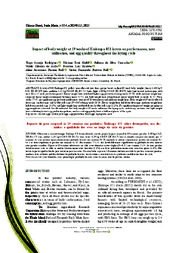Impact of body weight at 19 weeks of Embrapa 051 layers on performance, nest utilization, and egg quality throughout the laying cycle.
Impact of body weight at 19 weeks of Embrapa 051 layers on performance, nest utilization, and egg quality throughout the laying cycle.
Author(s): RODRIGUES, T. A.; GIEHL, D. Z.; CAMACHO, J. da S.; AVILA, V. S. de; KRABBE, E. L.; ROLL, A. A. P.; ROLL, V. F. B.
Summary: ABSTRACT: A total of 860 Embrapa 051 pullets were allocated into three groups based on their 19-week body weights (heavy: 1.48 kg ± 0.01 SD, N= 172 birds, medium: 1.32 kg ± 0.039 SD, N= 516 birds, light: 1.19 kg ± 0.019 SD, N=172 birds) and housed in floor pens with nests for a 65-week production period. Heavy-weight birds exhibited higher egg production during weeks 24-28, while medium-weight hens surpassed heavy-weight counterparts between weeks 41-46, and light-weight hens outperformed heavy-weight birds in weeks 61-65. From weeks 57-65, no significant egg production differences were noted between heavy and medium-weight hens. Body weight at 19 weeks affected floor eggs, cracked eggs, and double-yolk eggs (P < 0.05) during weeks 22-34. Heavy-weight hens laid fewer floor eggs, medium-weight hens had fewer cracked eggs (0.3%), and light-weight hens produced fewer double-yolk eggs (1.1%). No significant impact of weight grouping on egg weight was observed. Results indicated that body weight at 19 weeks influences the laying cycle, with heavy, medium, and light-weight hens exhibiting distinct egg production patterns, nest use and egg quality traits at different phases of the cycle. Key words: cracked eggs, double-yolk eggs, egg production, floor eggs, laying rate, nests. RESUMO: Oitocentas e sessenta frangas Embrapa 051 foram alocadas em três grupos de peso corporal às 19 semanas (pesadas: 1,48 kg ± 0,01 DP, N= 172 aves, médias: 1,32 kg ± 0,039 DP, N= 516 aves, leves: 1,19 kg ± 0,019 DP, N=172 aves) e alojadas em piso com ninhos por 65 semanas. As aves pesadas apresentaram maior produção de ovos nas semanas 24-28, enquanto as médias superaram as pesadas nas semanas 41- 46, e as leves superaram as pesadas nas semanas 61-65. Nas semanas 57 a 65, não houve diferenças significativas na produção de ovos entre as aves pesadas e médias. O peso às 19 semanas afetou ovos no chão, ovos trincados e ovos duplos (P < 0,05) nas semanas 22-34. As aves pesadas botaram menos ovos no chão, as médias tiveram menos ovos trincados (0,3%), e as leves produziram menos ovos com duas gemas (1,1%). Não houve impacto significativo do peso inicial no peso dos ovos. Em conclusão, o peso às 19 semanas influencia o ciclo de postura, com aves pesadas, médias e leves exibindo padrões distintos de produção de ovos, uso do ninho e características de qualidade em diferentes fases do ciclo.
Publication year: 2025
Types of publication: Journal article
Unit: Embrapa Swine & Poultry
Observation
Some of Embrapa's publications are published as ePub files. To read them, use or download one of the following free software options to your computer or mobile device. Android: Google Play Books; IOS: iBooks; Windows and Linux: Calibre.
Access other publications
Access the Agricultural Research Database (BDPA) to consult Embrapa's full library collection and records.
Visit Embrapa Bookstore to purchase books and other publications sold by Embrapa.

